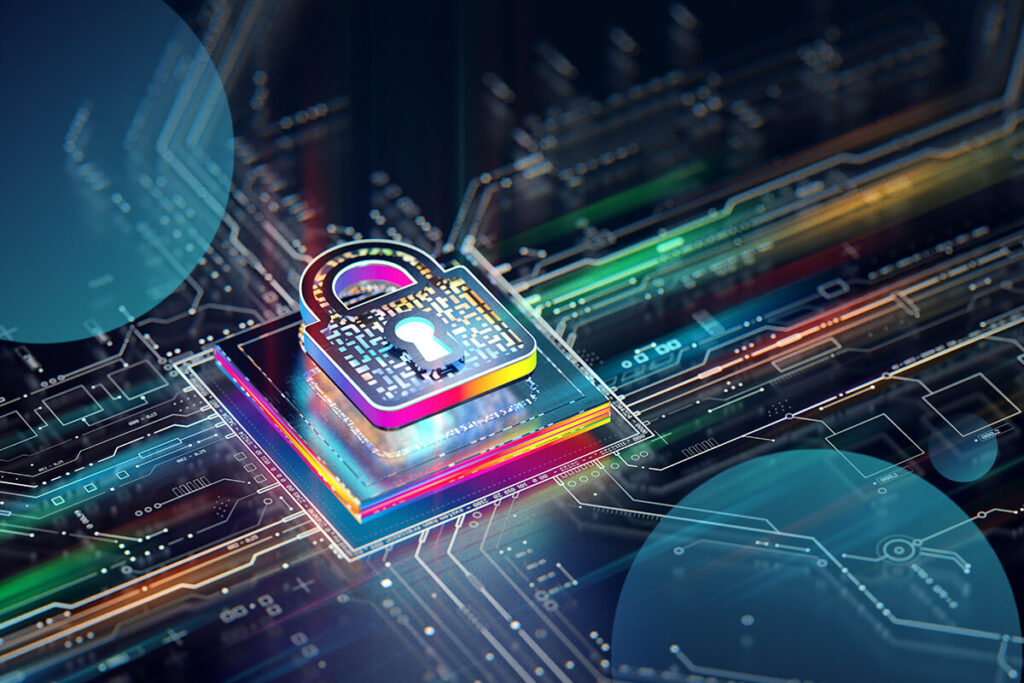
Without a doubt, the integration of artificial intelligence (AI) has transcended trendiness to become a pivotal agent of change in the rapidly evolving landscape of cybersecurity. Today, AI solutions hold the promise of revolutionizing the way enterprises identify, tackle, and neutralize cyber risks. However, innovations that incorporate AI and cybersecurity introduce new complexities that chief information security officers (CISOs) must skillfully navigate to minimize vulnerabilities and ensure the robust protection of their organizations’ information and resources.
Advancing security: The power of AI and cybersecurity
Artificial intelligence (AI) is transforming the field of cybersecurity and elevating standard security protocols with its advanced functionalities:
- Advanced threat identification: AI-infused systems meticulously examine large-scale data in real time, enabling the prompt detection of irregularities and potential hazards that might elude traditional security frameworks.
- Predictive analytics: Utilizing machine learning (ML) algorithms, AI can detect cyber dangers by analyzing patterns in historical data, thus equipping cybersecurity teams to preemptively counteract risks and establish solid defense mechanisms.
- Streamlined incident management: AI-powered automation accelerates the response to cybersecurity incidents, significantly reducing the impact and length of cyber assaults.
Ryan Hamrick, CBTS security consulting services manager, underscores the transformative impact of AI on cybersecurity: “Artificial intelligence empowers us to identify and mitigate threats faster and more accurately than ever before. It’s not just about defending against current threats but anticipating and preparing for future challenges.”
Read more: Defining security assessments: Risk, compliance, and security frameworks
Five top concerns for CISOs in 2024: Challenges to AI-enhanced cybersecurity
Looking ahead to 2024, critical challenges will arise from integrating AI with cybersecurity strategies. Chief information security officers (CISOs) will need to consider:
- Shifting threat environment: The swift advancement of both AI and cybersecurity technologies is altering the threat landscape for organizations. Both attackers and defenders are utilizing AI-enhanced tools, leading to a new breed of sophisticated and morphing threats that challenge established security norms.
- Adversarial AI: Malevolent entities are employing AI to craft advanced offensive techniques, such as adversarial AI, which can bypass conventional safeguards by imitating authentic user actions.
- Deceptive innovations: AI-crafted deepfake technologies pose a threat to both organizational integrity and cybersecurity by generating convincing but false content that can mislead individuals and machines alike.
- AI-powered offenses: Criminals are exploiting AI to enhance and scale their hostile activities, which intensify the velocity and impact of AI and cybersecurity incidents:
- Automated deception: AI-facilitated phishing schemes generate highly tailored and persuasive communications, markedly improving the odds of successful infiltrations via social engineering.
- AI as an offensive tool: Cybercriminals are applying AI algorithms to uncover system weaknesses, automate malware distribution, and carry out extensive, undetected data theft.
- Data governance and regulatory adherence: The integration of AI demands strict compliance with data protection laws and privacy benchmarks:
- Regulatory adherence: Chief information security officers must verify that AI implementations are in line with legal frameworks like the General Data Protection Regulation (GDPR), ensuring proper data management and strong privacy safeguards.
- Ethical AI deployment: The conscientious use of AI calls for an assessment of ethical considerations to counteract algorithmic biases and guarantee equitable and transparent decision-making.
- Operational integration and challenges: The incorporation of AI in cybersecurity within current systems presents technical and operational hurdles:
- Seamless AI integration: Merging AI with varied IT ecosystems and older infrastructures requires expert knowledge and careful planning for effective compatibility and minimal operational interference.
- Resource allocation: The upkeep of in-house AI infrastructures requires significant resource investment, continuous training, and support to maintain performance and cost-effectiveness.
- Professional development and expertise shortage: The rising demand for cybersecurity experts skilled in AI underscores the urgency for specialized training programs:
- Skill enhancement and learning: Firms should commit to ongoing training and certification to arm their staff with the skills needed for AI tool utilization in threat identification, incident management, and risk mitigation.
- Expert collaboration: Teaming up experts in AI and cybersecurity with seasoned security service providers is crucial for gaining the necessary knowledge and technical acumen to adeptly handle intricate cybersecurity implementations that are prepared for AI-enhanced threats.
“As AI continues to advance in cybersecurity, it offers advanced threat detection, rapid response capabilities, and predictive analytics,” said John Bruggeman, vCISO at CBTS. “However, these advancements also introduce new challenges for CISOs. One of the biggest concerns is ensuring the integrity of AI models, particularly against manipulation by threat actors. AI tools, while powerful, must be carefully monitored and secured to prevent misuse and potential breaches.”
Learn more: Navigating new frontiers in security: The rise of zero trust and AI endpoint tools
Mastering AI and cybersecurity: Effective strategies for mitigating concerns
Key initiatives for CISOs to address AI-enhanced challenges to cybersecurity and strengthen defense mechanisms in 2024:
- Active threat control: Deploy AI-driven surveillance systems for the immediate identification and scrutiny of potential threats, ensuring rapid containment and response to security incidents.
- Continuous learning and development: Cultivate an environment of perpetual education with extensive training initiatives that address AI and cybersecurity. Prepare personnel with the necessary skills for analyzing threat intelligence, neutralizing deepfakes, and thwarting hostile strategies.
- Stringent data management: Set up rigorous data governance policies that support safe and ethical implementation of AI in cybersecurity operations, protect critical data, and comply with legal regulations.
- United front in cybersecurity: Encourage collaboration between cybersecurity units, data analysts, and experts in AI and cybersecurity to develop customized AI strategies that meet organizational requirements and address new threats efficiently.
- Evolving security measures: Adopt flexible security protocols that utilize verifiable, reliable advancements for prompt verification processes, detection of irregularities, and evaluation of user activities, thereby enhancing protection against nascent cyber dangers.
Read More: AI infrastructure: Modern data management for insight-driven strategy
Final reflections: The balance of AI and cybersecurity
Emerging AI and its impact on cybersecurity presents a landscape filled with extraordinary opportunities to elevate the resilience of your digital defenses. Yet, the deployment of AI in this domain necessitates a vigilant evaluation of its associated risks and the establishment of preemptive strategies to counteract potential vulnerabilities. By placing a strong emphasis on education, fostering collaborative environments, and driving innovation, organizations can unlock the transformative power of AI in the realm of cybersecurity. As underscored by Ryan and John, “The evolution of cybersecurity will pivot on the judicious and creative employment of AI and cybersecurity, positioning us at the forefront of combating nascent threats and fortifying our digital future.”
Stay abreast of developments, remain proactive, and adopt strategies that marry AI and cybersecurity to create an essential collaborator in enhancing your organization’s defense mechanisms against the dynamic spectrum of cyber threats.
Reach out to talk with an expert today.
















